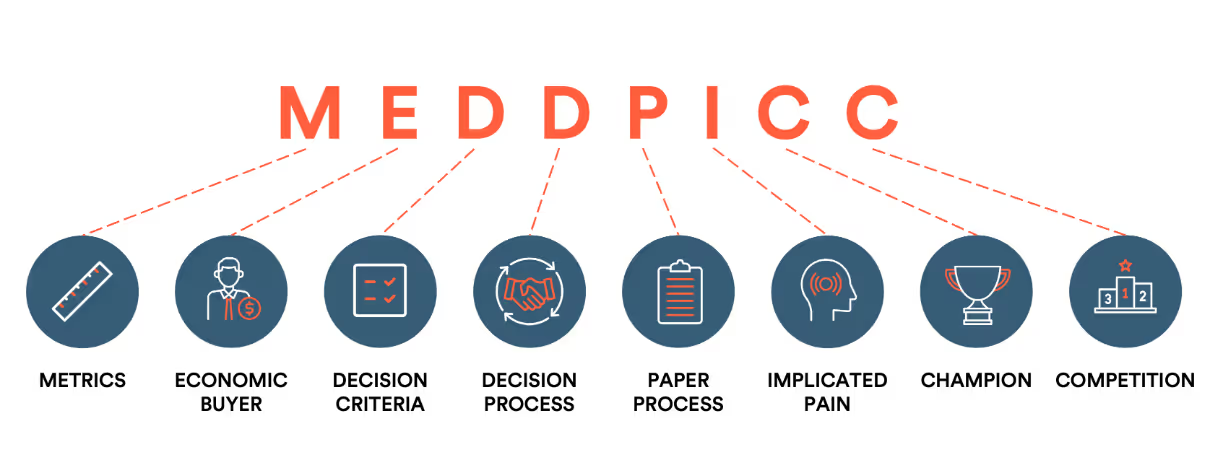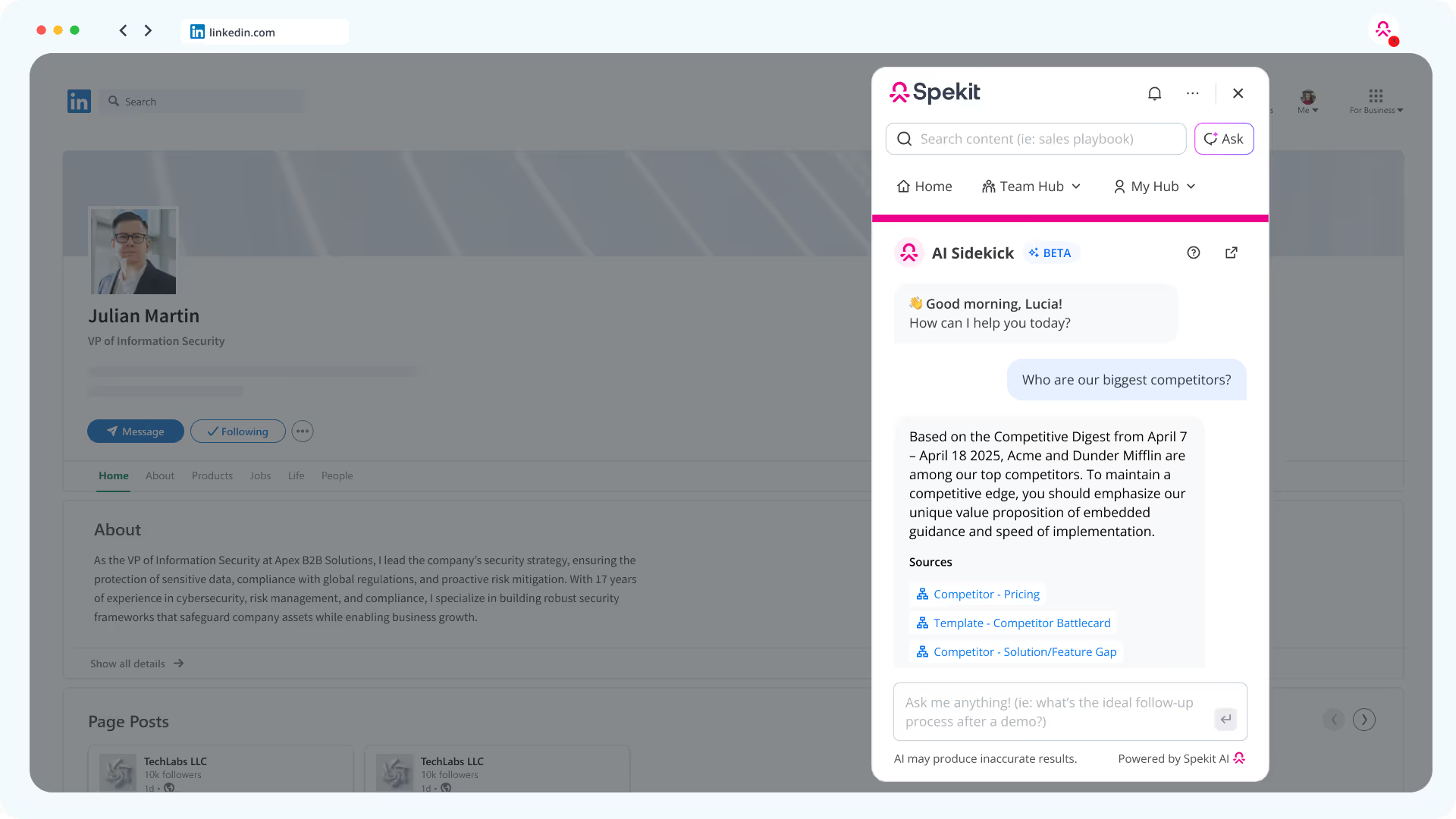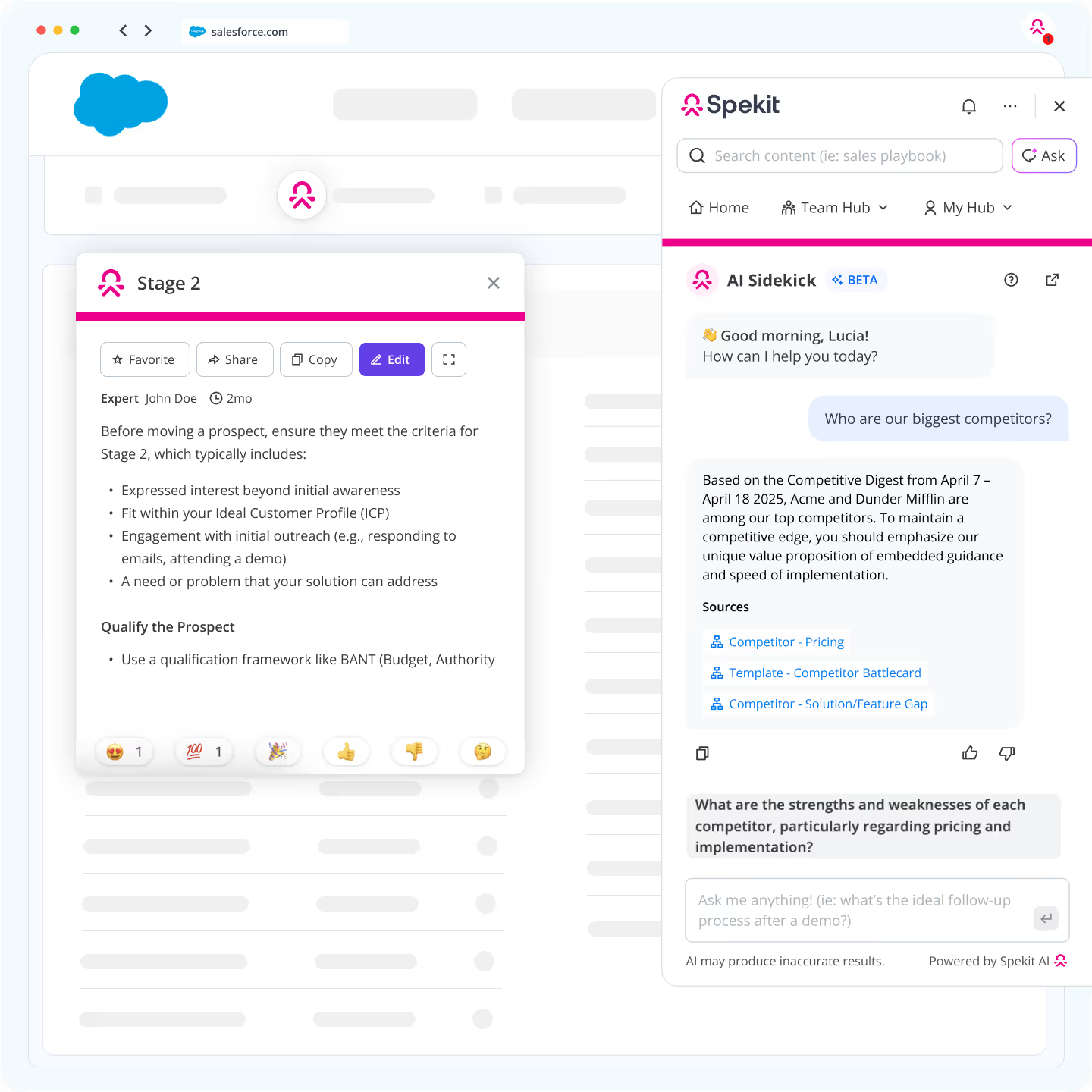MEDDIC is a renowned B2B sales methodology that’s been instrumental in guiding sales professionals since the 1990s. It helps sales reps ask the important questions at the right time to gather invaluable insights and create true connections.
It also provides a framework for sales reps to handle customer objections. 60% of customers will say no four times before saying yes, so mastering the art of objection handling isn’t just a nice to have; it’s a necessity to succeed.
MEDDIC is designed to assist in converting prospects–regardless of their position in the sales lifecycle–into loyal and paying customers. In this blog post, we’ll explore the six essential steps of the MEDDIC framework, why it’s an important methodology for your sales team to understand, and how to implement it.
What is the MEDDIC sales process?
The MEDDIC sales process is a B2B sales qualification methodology developed in the 1990s. It provides a framework to qualify better, develop, and close leads. Introduced by the PTC software company, MEDDIC is credited with fueling the company’s impressive growth from $300 million to $1 billion!
Since then, thousands of startups and B2B businesses have used the MEDDIC framework to build a healthy pipeline and accurate forecasts.
What does MEDDIC stand for?
MEDDIC is an acronym for the six steps in this sales qualification process:
We’ll expand on these further down the line. First, let’s look at how MEDDIC came into existence.
MEDDIC history
The origins of MEDDIC can be traced back to Parametric Technology Corporation (PTC), a software company founded in the mid-1980s. Executives at PTC developed the MEDDIC methodology to provide a more structured approach to sales qualification.
MEDDIC gained recognition as an effective sales qualification framework and started getting adopted by various sales organizations across different industries. Its systematic approach to understanding the buyer's perspective, identifying key decision-makers, and addressing specific pain points really resonated with sales professionals.
As the internet and digital technologies transform the sales landscape, MEDDIC continues to evolve. The methodology's adaptability and effectiveness in complex sales environments further solidified its reputation as a valuable tool for sales professionals.
Today, the MEDDIC sales methodology remains popular and widely used, helping sales teams across the globe to qualify leads effectively, prioritize opportunities, and improve win rates. It also evolved into other sales methodologies, MEDDPIC and MEDDIPICC (more on these later)!
The MEDDIC sales methodology

Metrics
Metrics are the quantifiable, measurable results that businesses and sales professionals use to gauge their performance and success. Metrics aren’t just random numbers–they serve as vital indicators that provide insights into various aspects of the sales process.
Sales teams use metrics to track and assess the effectiveness of their strategies and to make informed decisions for future actions. These measurable results encompass a range of data points, such as revenue figures, sales growth, customer acquisition rates, and more.
Metrics can be divided into two types: below the line and above the line.
Below the line: Metrics related to items like cost savings or efficiency.
Above the line: Metrics that include revenue, profits, time to market, and customer satisfaction.
Quick tip: your metrics will interest the prospect only if they’re aligned with the prospect’s goals. So start by asking a few qualifying questions!
MEDDIC Questions to Ask
- What are your current business goals?
- What efficiency or business-related metrics matter to you?
- How would success be measured by your business?
- In what timeframe are you looking to see measurable results or improvements?
- Are there any industry benchmarks or standards you aim to meet or surpass?
Economic Buyer
An economic buyer is a decision-maker: a person in the organization who has the authority to spend and drive the project.
Usually, it’s the person who handles the economic profit or loss of the project where your solution will be implemented. The economic buyer considers the big picture and has a clear view of the business benefits–which is why the decision to buy your solution will be made by them.
It’s important to research and be prepared to meet an economic buyer, since they could be your key to success. Do some checks about their decision-making process to be better prepared for the meeting. Think about the value proposition that your product brings to this specific person.
A successful meeting with the economic buyer would mean a greater chance of closing the deal–and the likelihood of closing can drop if a meeting with the economic buyer isn’t on the books.
MEDDIC Questions to Ask
- What do you need to make this project successful?
- Are you sponsoring this project?
- Will someone else be involved in the final decision-making, formally or informally?
- Can you share past instances where you’ve supported similar projects or initiatives within the organization?
- How does this project align with the organization’s long-term strategic goals?
Decision Criteria
In this MEDDIC step, we’re qualifying prospects based on the business’s decision criteria. A business has formal or informal decision-making criteria, which can be further divided into technical, legal, or business decision criteria.
Technical Decision Criteria: This looks at the criteria related to the technical extendibility and the current infrastructure of the organization, such as the organization’s current tech stack and ease of integration. If your solution is a great fit for your prospect’s needs but can’t sync with the organization’s current infrastructure, then there’s a slim chance the organization will consider your solution.
Business Decision Criteria: These criteria include all things related to revenue, cash flow, and budgets of the organization. An organization’s yearly OPEX or CAPEX budgets may also drive its business decision criteria.
By understanding and aligning your offerings to your client’s needs, you’ll project a helpful attitude–and be more likely to influence their decisions.
MEDDIC Questions to Ask
- What are your criteria for a buying decision?
- How are you calculating ROI to justify the project investment?
- What specific technical requirements do you have in mind for seamless integration with your existing systems?
- In terms of budget constraints, are there any particular aspects or features where cost-effectiveness is especially crucial for your decision-making process?
- Considering your business objectives, are there any regulatory or legal requirements that our solution must adhere to?
Decision Process
The decision criteria step is used to understand the components that could influence a buying decision. Just like the decision criteria, the decision process is categorized into three parts — a technical decision-making process, a business decision-making process, and a paper-based process.
Technical Decision Making
Technical decisions are based on the requirements and criteria of the company’s various tech leads, such as architects, business technologists, and operations managers. It’s important to understand the whole technical decision-making process, the people involved, and the way the client documents and confirms a decision.
Business Decision Making
Business decisions are usually linked to finances, making it important to understand the approval process that a business follows. For example, a formal board may need to approve the decision, or there may be a standard timeline that has to be followed.
Paper Process
Paper processes typically involve intense negotiations…and can definitely drag on. In fact, almost 60% of sales leaders think the deal agreement & signing stage takes way too long.
Fortunately, paper processes now happen digitally, which helps expedite the process. Consider using standardized templates for quotes and proposals, make sure your sales team knows exactly how to create, review, and approve sales documents, and train reps on the intricacies of your pricing structure and legal requirements.
By getting ahead of this step, you can reduce the time it takes to close a deal.
MEDDIC Questions to Ask
- What are the steps and their sequential order to arrive at a decision?
- How long does the decision-making process typically take? Are there any significant milestones or deadlines we should be aware of?
- Who are the key stakeholders involved in the decision process, and what are their roles? Are there influencers who might impact the decision?
- Are there any historical challenges or common roadblocks encountered in similar decision processes? How were they resolved, and what can we learn from those experiences to ensure a smoother process this time?
- Is the approval process different based on budget?
- What are the critical terms and conditions, and are there any frame agreements in place?
- Is there a legal review process?
Decision Criteria
The decision criteria step is used to understand the components that could influence a buying decision. Like the decision criteria, the decision process is categorized into three parts — a technical decision-making process, a business decision-making process, and a paper-based process.
MEDDIC Questions to Ask
- What are your criteria for a buying decision?
- How are you calculating ROI to justify the project investment?
- What technical requirements do you consider for seamless integration with your existing systems?
- Regarding budget constraints, are there any particular aspects or features where cost-effectiveness is especially crucial for your decision-making process?
- Considering your business objectives, are there any regulatory or legal requirements that our solution must adhere to?
Technical Decision Making
Technical decisions are based on the requirements and criteria of the company’s various tech leads, such as architects, business technologists, and operations managers. It’s important to understand the whole technical decision-making process, the people involved, and the way the client documents and confirms a decision.
Business Decision Making
Business decisions are usually linked to finances, making it important to understand the approval process that a business follows. For example, a formal board may need to approve the decision, or there may be a standard timeline that has to be followed.
Paper Process
Paper processes typically involve intense negotiations…and can drag on. Almost 60% of sales leaders think the deal agreement & signing stage takes way too long.
Fortunately, paper processes now happen digitally, which helps expedite the process. Consider using standardized templates for quotes and proposals, make sure your sales team knows exactly how to create, review, and approve sales documents, and train reps on the intricacies of your pricing structure and legal requirements.
By getting ahead of this step, you can reduce the time it takes to close a deal.
MEDDIC Questions to Ask
- What are the steps and their sequential order to arrive at a decision?
- How long does the decision-making process typically take? Are there any significant milestones or deadlines we should be aware of?
- Who are the key stakeholders involved in the decision process, and what are their roles? Are there influencers who might impact the decision?
- Are there any historical challenges or common roadblocks encountered in similar decision processes? How were they resolved, and what can we learn from those experiences to ensure a smoother process this time?
- Is the approval process different based on budget
- What are the critical terms and conditions, and are there any frame agreements in place?
- Is there a legal review process?
Identify Pain
An effective sales pitch solves the problem that the prospect is facing or might face in the immediate future. The “pain” is often around technical or business aspects negatively impacting your prospect’s business.
Address these by framing your product or service as the solution to these issues and emphasizing the benefits they’ll receive. Keep in mind that weak, unclear, or futuristic benefits without a timeline won’t be effective here.
For example, saying that your product will improve productivity might not be very impactful. However, suppose you state that your product can improve productivity by 30% and help save costs by 50k/year. In this case, you’re showing that your solution will directly affect the business’s time, cost, and revenue, making it more likely they will consider purchasing your product now.
MEDDIC Questions to Ask
- What are the current challenges that you are facing?
- How will these impact you or the business in both the short term and the long term?
- What are the consequences of not acting on the pain?
- Can you quantify the financial impact of these challenges on your business?
- How have you attempted to address these challenges in the past, and what were the outcomes?
- Who else in your organization is affected by these challenges, and what is their perspective on the situation?
Champion
A champion is a person who has a personal interest in resolving pain points. They’re usually influential, well-accepted by their peers, and have a great track record in successfully executing projects.
Since your product will directly impact how champions do business, you want them to see its immediate value. Identify champions and nurture them by addressing their specific issues. For example, connect them to subject matter experts, provide helpful information and references, and share relevant experiences of your other customers.
If you have a champion on your side, you’re well on the way to success.
MEDDIC Questions to Ask
- Does this person have the right influence?
- What will they gain, or what is their personal interest?
- Will they be able to explain the benefits of your product without your help?
- What is their level of commitment and enthusiasm?
- Have they successfully championed similar solutions in the past?
- What potential obstacles or resistance might they face internally?
MEDDIC vs. MEDDPIC vs. MEDDIPICC

The big difference between MEDDIC, MEDDPIC, and MEDDPICC is the addition of two components: Competition and Paper Process.
MEDDPIC
MEDDPIC places a strong emphasis on understanding the prospect's internal business needs. With an efficient paper process, sales professionals can navigate through intricate administrative hurdles, ensuring a seamless transition from negotiation to finalization.
Paper Process
We reviewed the “paper process” above. However, adding it as a separate step may not be necessary for every industry. For example, adding the paper process to the MEDDIC methodology may suit a government procurement contract. Government contracts often involve intricate bureaucratic procedures, extensive documentation, and adherence to specific regulations.
A defense contractor bidding for a significant military equipment contract faces a labyrinth of paperwork, including compliance documents, security clearances, and legal agreements. By employing MEDDPIC, the sales team can successfully navigate complex paper trails and gain a competitive advantage.
MEDDIPICC
MEDDIPICC directs additional attention toward understanding the competitors in the market. This knowledge equips sales teams to differentiate their offerings, anticipate competitor moves, and position their product or service as the superior choice in the eyes of the prospect.
Competition
Let’s consider a cloud-based sales training software provider aiming to expand its customer base. Multiple well-established competitors offer similar solutions–making differentiation challenging.
By applying the MEDDIPICC strategy, the sales team conducts a thorough study of the competition, identifying their strengths and weaknesses. Armed with this knowledge, they can tailor their pitch, emphasize unique features, and address shortcomings of competitors.
Should My Sales Team Use MEDDIC?
MEDDIC’s success lies in its ability to keep the prospect firmly at the center of the process, ensuring that every interaction is meaningful and purposeful.
But why should you train your sales team specifically for this approach? Let’s see.
Qualifies Leads
One of the fundamental challenges in sales is identifying leads with genuine potential. MEDDIC provides a structured framework that benchmarks your value proposition against the prospect’s needs.
By following its systematic approach, you can efficiently evaluate leads, ensuring you invest your time and efforts where they matter the most. This not only optimizes your resources but also significantly increases your chances of closing deals successfully. Sounds like a win-win!
Improves Communication
Effective communication is the bedrock of successful sales endeavors. MEDDIC offers a common language for your entire revenue team, streamlining internal communication and removing ambiguity.
With a shared understanding of the MEDDIC framework, your team can discuss prospects, strategies, and challenges with clarity and precision. This uniformity in communication fosters a cohesive team environment, where everyone is on the same page, working towards common objectives.
More Control
In the unpredictable world of sales, having control over the process is invaluable. MEDDIC empowers you with the tools to analyze cost-time effectiveness. It allows you to qualify leads based on solid data and insights, providing a clear roadmap for your sales activities. This enhanced control ensures that your efforts are focused and strategic.
Better Data
In today’s information age, data-driven decision-making is non-negotiable. Fortunately, MEDDIC is not just a checklist: it’s a robust data collection tool. By systematically identifying and uncovering prospect pains backed by data, you gain actionable insights into customer needs and motivations. This data can help you align your offerings effectively, building a sense of urgency that drives conversions.
Confident Sales Reps
When armed with a comprehensive understanding of the prospect's needs and a well-defined strategy, sales representatives approach interactions with assurance and conviction. This confidence resonates with prospects, building trust and credibility, essential ingredients for successful sales relationships.
The success of the MEDDIC sales methodology has been proven through its use to maximize sales efforts for multiple businesses across the globe. Statistics show that the framework is successful for both startups and established businesses.
Startups have seen a growth of over 250%, while the growth is 30% even in saturated markets.
MEDDIC Limitations
While MEDDIC is a powerful and effective methodology that can enable you to create the right sales process for your organization, it does come with certain limitations:
- Requires Comprehensive Data Gathering: The MEDDIC process involves in-depth research and data collection about the prospect, their organization, and the competitive landscape. This can be time-consuming and may require significant effort to gather all the necessary information.
- Complexity in Certain Industries: In industries with complex decision-making processes, like healthcare or government, understanding and navigating the intricacies of the "D" (Decision Process) and "P" (Paper Process) components can be particularly challenging.
- Skill and Training: Sales teams need training and practice to embrace and apply the MEDDIC methodology fully. It can be demanding to ensure that all team members consistently follow the framework.
- Potential for Over-analysis: There's a risk of overanalyzing each prospect, which could lead to slower sales cycles. It's crucial to strike a balance between thorough qualification and timely action.
However, the benefits of using MEDDIC far outweigh the limitations–and you can mitigate those limitations with Spekit.
Spekit is a just-in-time sales enablement platform designed to provide real-time guidance and knowledge reinforcement within existing workflows.
Spekit can help you better implement the MEDDIC sales process in several ways:
- Spekit integrates contextual, bite-sized information, termed Speks, directly into the daily applications and tools used by sales representatives. This ensures instant access to relevant guidance, minimizing the time spent searching for answers.
- Organizations can centralize and manage their sales enablement content, including training materials, product details, playbooks, and best practices. The platform facilitates effortless content updates and seamless sharing across the entire team.
- Streamlining the sales onboarding process, Spekit provides new hires with access to training materials and resources within their workflow. This accelerates the onboarding period, ensuring that representatives are well-prepared to engage effectively with customers.
- Spekit offers robust sales enablement analytics and reporting features, allowing organizations to monitor employee engagement with content. This data-driven approach identifies areas where representatives might require additional support, facilitating continuous improvement in sales enablement efforts.
- Equipped with powerful search functionality, it allows users to swiftly locate specific information related to products, pricing, objection handling, and other facets of the sales process.

It doesn't matter if you’re using MEDDIC, MEDDPIC, or MEDDIPICC. Spekit integrates the frameworks into their sales flow–ensuring that every sales and revenue team can collaborate and close deals swiftly with the answers, coaching, and support they need instantly accessible.
How to Implement MEDDIC Sales Methodology
Implementing the MEDDIC sales methodology is not just about understanding the acronym; it’s about embedding it into the DNA of your sales organization. Here’s a detailed guide on how to ensure that every member of your team speaks the same language and follows a cohesive approach:
Learn more about your buyers
Before going into the MEDDIC framework, it’s essential to have a solid understanding of your buyer personas. These personas should be updated and refined during MEDDIC training. Understanding your ideal customer's roles, challenges, and aspirations will prevent your sales team from failing, and help them identify and engage with the right prospects and economic buyers effectively.
Review sales objections and win-loss data
Sales objections are inevitable, especially when employing a methodology like MEDDIC that encourages deep, probing questions. Your sales team must be prepared to handle objections related to price, trust, contracts, or any other concerns.
Regularly review win-loss data and objections encountered during MEDDIC-guided interactions. Use this feedback loop to refine your approach continually.
Refine sales qualification criteria
Map your current sales qualification process against the MEDDIC framework. Identify gaps and areas of improvement. There might be a learning curve, and unlearning certain habits might even be necessary.
Encourage your sales and marketing teams to adapt to the changes and provide them with the necessary resources and support.
Map interactions to the MEDDIC process
Documentation is key to successful MEDDIC implementation. Encourage your sales team to document every customer interaction meticulously–especially during and after discovery calls. Create standardized templates aligned with the MEDDIC steps.
In your CRM tool, integrate fields corresponding to the MEDDIC process. This not only helps in streamlined documentation but also provides a clear, common language for your sales, marketing, and service teams.
Implement MEDDIC sales training into your flow of work
In today’s remote and hybrid work environments, it’s challenging to ensure sales reps consistently apply frameworks like MEDDIC. Standard training libraries and static LMS courses don’t provide the contextual, real-time support reps need when they’re actually working deals.
That’s why it’s critical to embed MEDDIC directly into the tools reps already use. With Spekit, MEDDIC training isn’t a one-time event, it’s continuously reinforced in the flow of work™:
- AI Sidekick surfaces MEDDIC checklists, objection-handling content, and coaching directly inside Salesforce, Gmail, Outlook, or call intelligence tools.
- Speks provide bite-sized, contextual reminders so reps can recall MEDDIC steps at the exact moment they’re qualifying opportunities.
- Deal Rooms enable teams to package and share MEDDIC-aligned resources with buyers, while tracking engagement to refine strategy.
- Change management notifications ensure every rep stays aligned as processes, playbooks, or qualification criteria evolve.
- Analytics connect usage of MEDDIC training to pipeline progression, making it easy to prove adoption and impact.
By weaving MEDDIC into everyday workflows, Spekit transforms it from a training module into a living, breathing sales discipline, helping reps qualify better, forecast accurately, and close with confidence.
That’s why it’s essential to leverage sales training tools to enable and empower each sales representative with the real-time support and guidance they need to move pipeline through the funnel.

Get full buy-in from sales managers
MEDDIC implementation should be embraced wholeheartedly across your organization, and sales managers play a pivotal role in reinforcing the methodology. They need to not only instill the basics of MEDDIC within the sales team but also ensure its adoption is consistent and universal.
You need to provide regular coaching sessions and facilitate discussions where best practices and next steps are shared and learned among teams.
MEDDIC Questions List
Remember that MEDDIC has a number of questions that you need to ask under every acronym. Here’s a consolidated list of the ones highlighted in this blog post:
More about MEDDIC
Here’s some additional information about MEDDIC:
Who created MEDDIC?
MEDDIC evolved at Parametric Technology Corporation (PTC) in the 1990s. The creation is often attributed to Dick Dunkel and Jack Napoli, who both worked at PTC.
Is there a MEDDIC book?
Yes, there’s a book called MEDDICC: The ultimate guide to staying one step ahead in the complex sale by Andy Whyte, with a foreword by Dick Dunkel and Jack Napoli.
Where do you get a MEDDIC certification?
The MEDDIC Academy offers on-demand online courses, both virtual and in-person, for different curricula, such as individual contributors, managers, and trainers. They also offer vILT programs (virtual Instructor-Led Training), live online workshops, and in-person training and workshops.
MEDDIC Sales Process vs. Challenger
MEDDIC and Challenger Sales are both influential sales methodologies–but they approach sales in different ways. MEDDIC is prospect-centered and focused on deeply understanding the customer's needs and motivations.
The Challenger Sales methodology emphasizes teaching sales reps to challenge the customer's thinking and introduce new perspectives. It involves tailoring sales conversations based on the customer's profile – whether they are a "Challenger," "Lover," "Friend," or "Hard Worker."
Implementing MEDDIC with Spekit
Spekit brings MEDDIC into the flow of work to ensure MEDDIC isn’t a one-off training but a continuous part of daily selling.
Learn how Spekit supports MEDDIC
Optimize your MEDDIC sales methodology
MEDDIC is a robust sales framework that keeps the prospect at the center of your process. With each step in MEDDIC, a sales rep is better positioned to ask relevant questions and gather valuable data that will take them one step closer to converting the lead.
Proper training and reinforcement of MEDDIC steps and processes are crucial for effective implementation. Sales enablement tools like Spekit, including its sales playbook software, can make this easier and empower the sales rep by surfacing relevant, contextual training during the sales process.
To know more about how you can empower your sales team with the right training and processes, get started with Spekit for sales enablement.

.avif)





